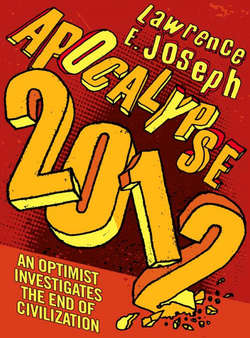Читать книгу Apocalypse 2012: An optimist investigates the end of civilization - Lawrence Joseph E. - Страница 25
4 HELLFIRES BURNING
ОглавлениеAs we bobbed in a boat in a cove in the harbor of Heimaey, in southwestern Iceland, Hjalli, the captain, beseeched God’s mercy for twenty minutes, begging that we might survive. We were about to set out for Surtsey, the youngest island in the world, named for the giant in Icelandic mythology who keeps the hellfires burning. When Surtsey emerged on November 14, 1963, the ocean boiled. The crew of a fishing boat in the area was too busy with their nets to notice anything, until a great black column rose out of the water, blotting out the horizon off the bow. Four more years of volcanic eruptions formed the pudgy half-square-mile teardrop, which ever since has refused to submerge, despite being in one of the stormiest places on Earth, with more than 200 gale-force days annually, and waves up to 85 feet high.
From its birth, Surtsey was set aside as an ecological preserve, completely off limits to tourists, with no permanent structures of any kind, including docks or even moorings, permitted. It had taken me a year to get all the permissions to visit, and this after having been personally invited by Iceland’s president, Vigdis Finnboggadottir. But when Hjalli finished praying and then blew his trumpet to let Gabriel know we might be seeing him soon, I wondered aloud whether we shouldn’t just putt-putt around the harbor for a while and agree among ourselves that the Surtsey trip had been, well, beyond words.
My assignment was to write a magazine piece about how Surtsey developed an ecosystem, how a steaming hunk of lava rock surrounded by salt water comes alive. Birdshit, in a nutshell. I understood from the research that ocean-going birds eat fish and poop on the island, providing fertile spots for seeds blown in the wind and washed up from the ocean surface. Sea sandwort, a tenacious green succulent with white and yellow flowers, is usually the first colonizer, because its hammocklike structure traps the sand that the plant’s roots need to keep from being blown away by the fierce ocean winds. All in all quite interesting, but not worth perishing at sea.
Snorri, the naturalist assigned as my guide, confirmed that Hjalli was the only captain experienced enough to land safely at Surtsey and advised me to overlook the fact his other boat had been smashed to fiberglass bits on the jagged shoreline. All hands, after all, had survived. Besides, added Snorri, a Christian fundamentalist, the next life is bound to be better than this one.
That 1993 trip to Surtsey turned out to be an unforgettable afternoon, sliding down black aa lava tongues as long as the escalators in the London Underground, climbing into huge vagina-shaped craters and rolling around in their luscious green moss, warming our hands over fissures sputtering sulfurous steam.
After ducking a raven with a wingspan as wide as my arms, Snorri asked me if I was hungry, then had himself a good laugh. The joke went right over my head, but Rasta Cabbie would have gotten it right away. Jah, I now realize, refers to Elijah, the Old Testament prophet whose story in I Kings is what Snorri was referring to. Under the wicked King Ahab, the Hebrews had turned away from God, who decided to punish the land of Israel with three and a half years of bitter drought. God instructed Elijah to tell Ahab of the drought that would come, then flee Ahab’s wrath by hiding at the brook of Cerith, where Elijah was kept alive by ravens bringing him food.
It wasn’t until I met the Barrios brothers in Guatemala a dozen years later, however, that I understood the true import of that trip: Surtsey was my first glance at what our future might look like physically: a postvolcanic desert. What I had always back-of-the-minded as a remote if cataclysmic possibility may well be impending, as Yellowstone, one of the world’s largest supervolcanoes, gets ready to blow.
